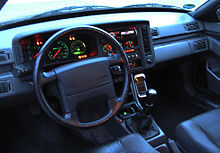Volvo 480
The car was originally intended to be marketed in the United States as a 2+2 "sports wagon" in the fall 1987, although these plans were cancelled in part due to the continued weakness of the U.S. dollar during 1987.
[16] The federalized engine, however, did allow Volvo to export the 480 Turbo to Japan in 1989 with some additional minor changes to the trim and side markers.
The concept was to market a modern, compact front-wheel drive car with a unique low-slung design targeting buyers "between 25 and 40, probably with a higher than average education and with a career.
"[3] Designed by Volvo's Dutch subsidiary, the "sporty 480 ES coupé" was introduced to change the automaker's "frumpy image" and into the "yuppie" market segment.
[15] Daytime running lights, illuminated driver's door lock, follow-me-home headlights with 30 second delay & automatic rear wiper in reverse gear were among the electronic features that were considered advanced for the time.
A fully electronic 'Info Centre', which incorporated a fuel gauge as well as 7 other measurements including estimated range, instant MPG and average speed was standard on most models.
The all-leather interior was specially designed by the German artist Wolf Cieciersci and featured a red, green, and brown hand painted pattern, unique to each car and no two sets of seats were the same.
A ruched leather interior, 15-inch 6-spoke Cetus alloy wheels, and air-conditioning (in-lieu of a moonroof) were among the standard features found on the Celebration.
[22] Motor Sport magazine commented on the sporty, but "obedient" handling, with "minimal understeer" and a stable chassis during cross-winds.
[23] Despite this, poor build quality and reliability at launch led to one Dutch car magazine to dub it the "coupe from hell".
"This meant there was some danger of a sporty steer — pretty radical from a company that considered having fun at the wheel as acceptable as seducing a nun," he commented.
He also commented on the last versions for the United Kingdom as, "And Celebration it was too, as Europe waved goodbye to the badly built, pointless, DAF coupé with an outrageous asking price of £16,500.
It was planned to be launched at the beginning of 1991, but did not make production after a supplier declared bankruptcy, and concerns over rollover safety protection.
[20] A Targa top was also proposed by the American Sunroof Company based in Detroit, but never made it past the prototype stage.




